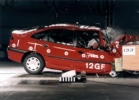Protection of the driver and passenger

Frontal blow, driver |

Loba blow, passenger |

Side blow, driver |
 | - | Excellent |
 | - | Good |
 | - | Satisfactorily |
 | - | Badly |
 | - | Very bad |
|
Children's holding devices
| Child up to 18 months |
No information |
| A child over 3 years old |
No information |
Safety of pedestrians
 |
 | - | Excellent |
 | - | Good |
 | - | Satisfactorily |
|
Comments:
Significant changes are made to the protection system when hitting the side in May 1997. Here are the results of testing an earlier model.
Frontal blow:
The front stand from the driver's side shifted back 145 mm. It was not possible to open the driver's door manually, but the passenger door opened normally. The steering wheel shifted back 94 mm and up to 42 mm. The deepening for the legs was moderately deformed, and the brake pedal “went” back 200 mm. Based on the testimony of mannequins, the driver’s head protection could be recognized as good, but her contact with the airbag was not stable. The neck was safe, and the deterrence systems prevented the chest with the steering wheel. Strong load limiters worked effectively, the risk of breast damage was low, although pressing the torpedo into the salon was a danger to drivers of various complexions located closer or further from the steering wheel. The driver’s left knee hit the steering column casing and the lever of adjusting its position, which was at risk of injury. The bracket for adjusting the position of the steering column can lead to damage to the knee. The right knee hit the panel near the fuse box. There was a risk of damage to the knee, lower leg and pelvic region. If the blow fell a little to the left. The higher position of the knee would lead to a blow to the ignition lock. The readings of the mannequin sensors signaled the poor protection of the lower part of the legs. The degree of damage to the deepening of the legs suggests the likelihood of injury to the feet or ankles. In the frontal impact, the general risk of getting damage to the passenger was insignificant, although it was higher for the left leg.
Safety of passenger children:
When hitting the side of the mannequin, a large breakthrough of the head recorded a large jerk. Her blow was recorded on the side edges of the chair.
Side blow:
The “ribs” of the mannequin recorded a high load, which is why the rating for protecting the chest was reduced. The protection of the head and pelvis is recognized as good.
Pedestrian safety:
Protection of the head of the child. Only one control point out of six met the requirements: under the air intake. The other two showed the result above average. Protection of the upper part of the legs - not one of the control points was complies with the requirements. Protection of the head of an adult pedestrian - three points met the requirements (above the wiper, on the edge of the hood cover and one on the cover itself). Feet protection - none of the control points corresponded to the requirements (one, at the bumper, protected better than average, two - worse).
General information about the car
| The location of the steering wheel |
On right |
| Tested model |
Renault Laguna 2.0 RT |
| Type of body |
5-door hatchback |
| Year of data publication |
1997 |
| Curb weight |
1313 |
Safety system equipment:
| Front seat belts |
There is |
| Front seat belts load limiters |
There is |
| Front Pillow of Safety of the driver |
There is |
| Passenger front pillow |
Not |
| Side airbags |
Not |
| Side pillows of head safety pillows |
Not |
| Knee -off pillow and legs of the driver |
Not |
















